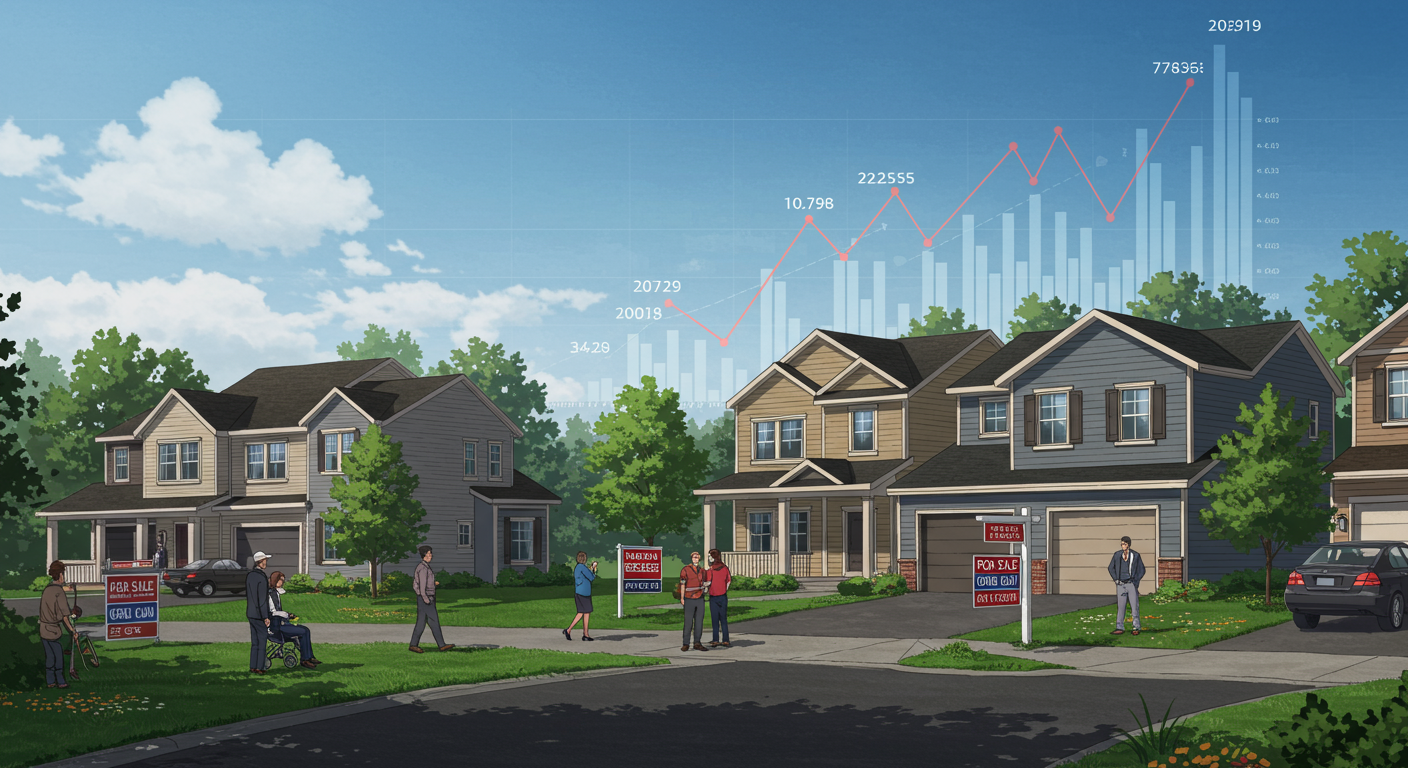July Sees a Huge Mortgage Rate Drop and More Inventory on the Market
Quick Take:
In July, the average 30-year mortgage rate declined significantly, by 0.50%, positively affecting affordability. Economists predict that mortgage rates have already seen their peak this year, near 6%, and will stabilize around the current rate of about 5%.
Homebuyers had more inventory to choose from than this time last year, which indicates that the market is becoming healthier.
The economy feels uneasy, but the housing market isn’t showing signs of a major reversal.
Note: You can find the charts & graphs for the Big Story at the end of the following section.
Home prices continue to reach new highs even as demand declines
Home prices generally stagnate this time of year, so it’s more challenging to ascribe causation for why price growth has decelerated nationally to economic factors — inflation, mortgage rates, supply shortages, and looming recession — when they coincide with long-term seasonal trends. Historically, prices increase in the first half of the year and flatten in the back half. Prices in 2020 bucked this trend, increasing through October before flattening in the last quarter of the year. Although prices rose much higher in 2021, the historical trend returned. This year has, of course, come with different economic and psychological drivers than 2020 and 2021, especially in the housing market.
For many, if not most of us, the pandemic brought us largely inside our homes, increasing the desire for larger, nicer private spaces. The mass movement to remote work meant that proximity to an office, usually a primary selling point in major metro areas, mattered less or not at all. Many of us experienced our home spaces, work spaces, and communal spaces becoming one, and realized that the home we usually spent little time in would simply no longer work for us. This need for a bigger space, combined with extremely low-rate financing, a substantial increase in disposable income, and more time to look for a new home created a boom in demand in an already undersupplied housing market. As a result, the median sale price rose higher and faster than any other point in history, up 36% over the past two years according to data provided by the U.S. Department of Housing and Urban Development. For reference, in the eight years preceding 2020, the median home price rose a total of 38%.
As we know, housing isn’t the only asset to rise since 2020. Nearly everything has become more expensive, and inflation (CPI)*, which has rarely ever risen above 5%, ticked above that mark in the summer of 2021 and has only increased since then. The Federal Reserve, which has a dual mandate of price stability and maximum employment, has one major tool: raising the federal funds rate†. By doing so, the Fed indirectly affects the debt markets, thereby increasing other interest rates, such as mortgage rates.
In the first half of this year, the average 30-year mortgage rate rose nearly 3%. It’s hard to overstate how significantly that rate increase affects affordability. To hopefully simplify the explanation, we will use a $1 million home that is fully financed for illustrative purposes. For a $1 million home, a 3% increase in interest rates raises the monthly mortgage cost by 42%. It’s fairly safe to say that income hasn’t risen by 42% for most people, which means that many potential buyers are priced out of buying homes, softening demand. For those potential buyers waiting for a correction of the residential real estate market, home prices would have to decline by 30% for the monthly costs to be equivalent — that is, $700,000 at 6% is the equivalent monthly mortgage cost of $1 million at 3%. If the housing market experienced such a large correction, there would likely be much larger concerns in the global economy than home prices. Barring a collapse of the entire financial system, supply would simply be too low for a major correction. Luckily for potential homebuyers, mortgage rates dropped by 0.50% in July, and many economists predict that the mortgage rates will flatten out around 5% even as the Fed continues to raise the federal funds rate. This is partial because the market largely understands and has already accounted for the Fed’s rate hike path, which will continue until inflation begins to meaningfully decline and recession worries wane.
The economy has felt a little uneasy lately — a classic “will they, won’t they?” when it comes to the recession — but for now, we aren’t technically in a recession because job numbers are too good. Demand for homes has clearly softened, which is fine in a severely unbalanced market. We will likely see less significant price appreciation in the second half of the year due to seasonal norms and higher mortgage rates. The market remains competitive and homes are selling quickly. However, buyers are seeing more inventory than last year, which is good for the market. As always, we will continue to monitor the housing and economic markets to best guide you in buying or selling your home.
Big Story Data
The Local Lowdown
- Like the rest of the country, home prices in the Greater Bay Area have hit a ceiling after two years of substantial growth along with hitting the seasonal summer slowdown.
- Demand for homes is clearly softening, as sales decline despite more inventory.
- New listings declined in July, a seasonal norm, which means that inventory in 2022 will likely peak at historically low levels.
Note: You can find the charts/graphs for the Local Lowdown at the end of this section.
Is the market balancing? Tentatively, maybe!
The median single-family home and condo prices in the Greater Bay Area continued to decline from their peaks reached earlier this year. These movements are within the bounds of normal price variability, but after large price gains, it feels like any downward movement signals a market correction. As mentioned in the Big Story, prices tend to stagnate in the summer and fall months when inventory is at its highest, so we aren’t ringing the alarm bells quite yet. Homes over the past five years have become less affordable, yet demand boomed. With 30-year mortgage rates potentially settling around 5%, fewer potential buyers will participate in the market than they did last year when mortgage rates were at all-time lows.
Supply is still historically low, which will protect prices from experiencing a major downturn. Prices will likely follow a similar trend as last year, holding relatively steady through the summer and fall months. If you’re following home prices closely, as we tend to do, you don’t need to worry about losing the equity in your home, or softening demand, or even an official recession — so long as it doesn’t affect your job. The housing market remains strong in the Greater Bay Area.
Sales slowdown
July saw housing inventory rise in the North Bay and East Bay, but decline in Silicon Valley and San Francisco. Inventory tends to peak in the summer months, which appears to be the case this year. We entered 2022 with the lowest inventory in history, but the number of homes for sale has risen considerably since December 2021 in each Bay region except for San Francisco. Although the supply of homes is still far from pre-pandemic levels, we’ve been pleased to see that inventory at least increased in the first half of the year. With the substantial drop in sales and new listings from June to July 2022, the peak inventory levels for 2022 will likely be the lowest on record.
The steep decline in sales indicates that demand is softening. We aren’t saying that demand is low, but it’s trending closer to a balance between buyers and sellers than we’ve seen in years.
Months of Supply Inventory inches toward a more balanced market
Months of Supply Inventory (MSI) quantifies the supply/demand relationship by measuring how many months it would take for all current homes listed on the market to sell at the current rate of sales. The long-term average MSI is around three months in California, which indicates a balanced market. An MSI lower than three indicates that there are more buyers than sellers on the market (meaning it’s a sellers’ market), while a higher MSI indicates there are more sellers than buyers (meaning it’s a buyers’ market). Notably, single-family home MSI has climbed higher over the past four months with the exception of San Francisco, but remains well below three months of supply, indicating that the Greater Bay Area is still experiencing a sellers’ market.
Local Lowdown Data



























